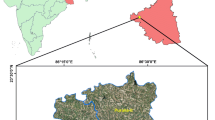Summary
The Darjeeling Himalayas, with its perenial rivers flowing through narrow gorges amidst high ranges, provides considerable scope for Hydro-Power development. Six major rivers, the Jaldhaka, Rammam, Rangit, Mahananda, Balason and Teesta, which straddle through this mountainous region, offer a cumulative power potential, of the order of 1200 M.W. at 50 % load factor. Various river valley schemes have been envisaged to utilise their power potential and some of these schemes have already been executed.
The region is geologically complex, terrain-wise difficult and seismically active. The constituent geological formations range from late Tertiary to Precambrian gneisses. The Palaeozoic and Precambrian constitute several thrust sheets piled one over the other, the older rocks exhibiting increasing grades of metamorphism. Structurally the rocks are highly fractured, faulted and folded. Past glacial and frost action as well as stream erosion on the fractured rock mass has given rise to a thick pile of overburden along the valley slopes.
The present paper deals with the nature of major geotechnical problems in the region and their impact/significance in the planning and execution of hydro-electric projects in the area.
Résumé
L'Himalaya de Darjeeling, avec ses rivières pérennes coulant dans de gorges étroites au milieu de chaînes élevées, présente d'importantes possibilités de construction de centrales hydro-electriques. Six importantes rivières (Jaldhaka, Rammam, Rangit, Mahananda, balason et Teesta), qui galopent à travers cette région montagneuse, présentent ensemble une possibilité de production de l'ordre de 1200 MW à demi charge. Plusieurs aménagements de vallées ont été envisages pour utiliser cette énergie potentielle et plusieurs de ces aménagements ont déjà été exécutés.
La région est géologiquement complexe, difficile en ce qui concerne le terrain et séismiquement active. Les formations géologiques qui la constituent s'étagent du Tertiaire supérieur aux gneiss précambriens. La Paléozoique et le Precambrien constituent stituent plusieurs nappes de charriage empilées l'une sur l'autre; plus les roches sont anciennes, plus elles présentent un degré de métamorphisme accentué. Au point de vue de la structure, les roches sont très fracturées, faillées et plissées. Les glaciations anciennes, le gel et l'érosion fluviatile, agissant sur la masse de roches fracturées, ont donnée naissance à d'importants dépots alluvionnaires de long des pentes de vallées.
L'article trait de la nature des grands problèmes géotechniques de la région, de leurs conséquences et de leur importance pour la préparation et l'exécution de grands trauvaux hydro-éléctriques dans la région.
Similar content being viewed by others
References
AUDEN J.B. (1935): Traverse in the Himalayas. Rec. G.S.I., Vol. 69, Pt. II.
AUDEN J.B.—NICKEL F.A.: Cited in the unpublished G.S.I. progress Report on the Preliminary Geological report on the Teesta Valley for the selection of a site for a High Dam by M.S. Jain (1960).
CHOUDHURI A.K. (1971): Geological setup and its influence on tunnelling condition, Jaldhaka Hydel Project, Darjeeling dist., West Bengal. Seminar on Engng and Geological problems in tunnelling. Ind. Soc. of Engng Geol.
GANSSER (1964): Geology of the Himalayas.
GHOSH A.M.N. (1956): Recent advances on the geology and the structure of the Eastern Himalayas. Presidential Address. Ind. Soc. Cong., Agra.
HEIM—GANSSER (1939): Central Himalayas.
KING L.G.: Cited in “Geodynamics Project”. Departmental publication of Geol. Surv. Ind. (1973).
KAILA K.L.—HARINARAYAN (1976): Evolution of the Himalaya based on seismotectonics and Deep Seismic soundings. Himalayan Geology Seminar, New Delhi.
MALLET F.R. (1975): Geology of Darjeeling dist. and the western Duars. Mem. G.S.I., Vol. II, Pt. I.
MEARES J.W.: Cited in the “Report on the Jaldhaka Hydro Electric Project” by W.B.S.E.B. (1958).
PAWDE M.B.—SAHA S.S. (1967): Geological mapping in parts of Darjeeling dist., W.B.G.S.I. unpublished Progress Report.
RAO Y.S.N.—RAHAMAN A.A.—RAO D.P. (1974): On the structure of the Siwalik range between the rivers Yamuna and Ganga. Him. Geol., Vol.
RAY S. (1947): Zonal metamorphism in the Easterm Himalayas and some aspects of local geology, Quart. Jour. Geol. Min. Met. Soc. India, Vol. 19, No. 4.
ROY S. (1975): Jaldhaka Hydro-electric Project, Stage I, West Bengal. G.S.I. Misc. Publication No. 29.
SEN SARMA S.B.—CHOUDHURI A.K. (1972): Geological studies during the planning and construction stage of Jaldhaka Hydro-electric Project, W.B. Dr. J.B. Auden Commenorative Volume, Indian, Soc. Engng Geol.
Author information
Authors and Affiliations
Rights and permissions
About this article
Cite this article
Chatterjee, B. Geotechnical problems in planning and execution of an hydro-electric project in Darjeeling Himalaya. Bulletin of the International Association of Engineering Geology 20, 73–77 (1979). https://doi.org/10.1007/BF02591250
Published:
Issue Date:
DOI: https://doi.org/10.1007/BF02591250




